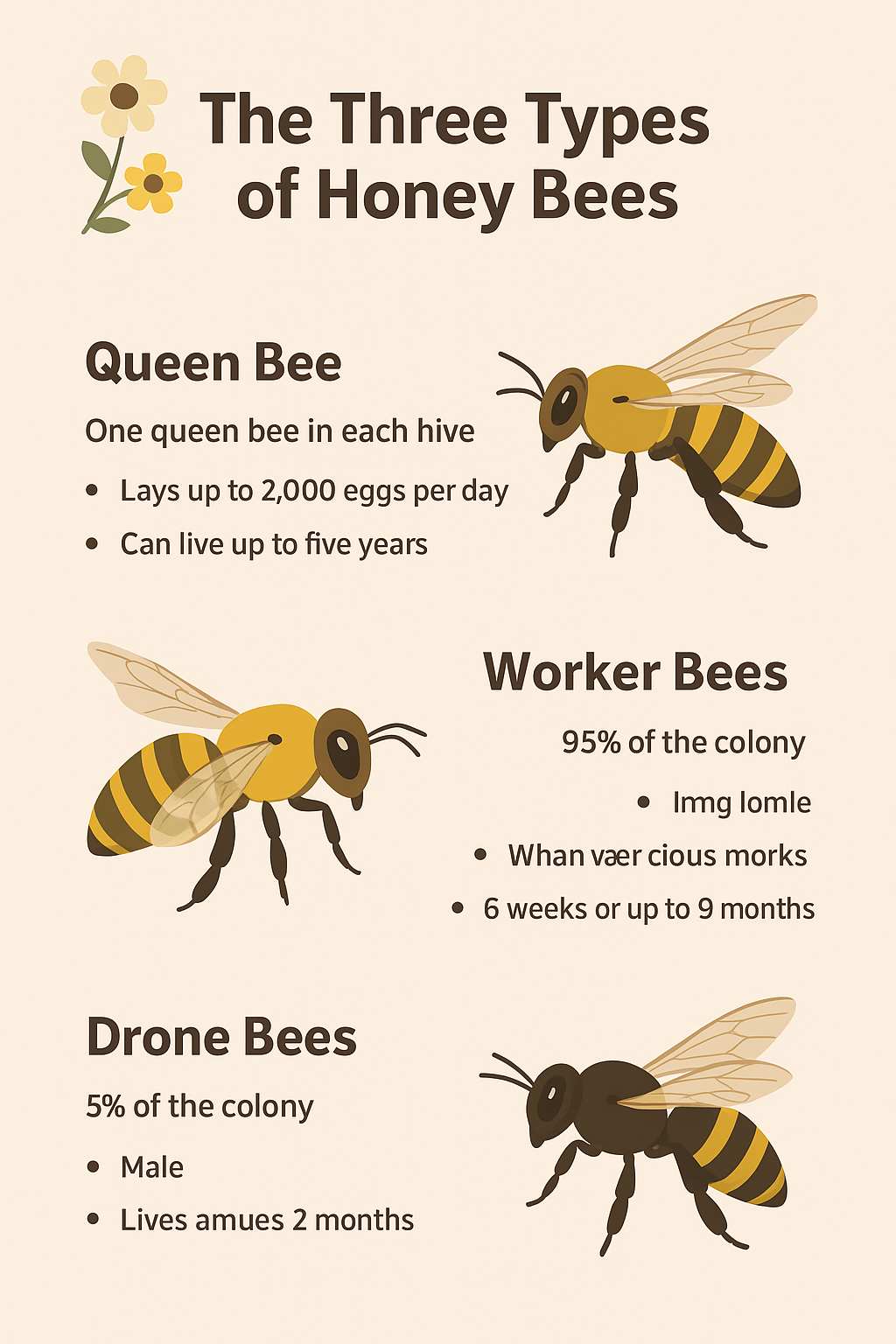For many people, all bees look the same buzzing little insects flying from flower to flower. But inside a honey bee colony lies a perfectly organized society with three distinct types of bees, each playing a vital role in keeping the hive alive and thriving.
Meet the queen, the workers, and the drones three castes, three lifestyles, and one harmonious community.

Table of Contents
The Queen Bee – The Heart of the Colony
At the center of every thriving hive is one queen bee, the mother of them all. She’s slightly larger than the worker bees, moves with calm authority, and has
one mission: to reproduce and ensure the colony’s survival.
A healthy queen bee can lay up to 2,000 eggs per day during peak season. Each of these eggs can grow into a worker bee, a drone, or even another queen depending on how it’s cared for.
- Fertilized eggs become workers or queens.
- Unfertilized eggs become drones.
Future queens are raised in special royal cells and fed royal jelly, a nutrient rich substance that gives them their fertility and size.
The queen rarely leaves the hive except for her nuptial flight the moment she mates with multiple drones in the air. After that, she returns home and spends the rest of her life laying eggs.
She can live up to five years, though most queens are replaced after two or three. When a new queen is born, she often fights the old queen only one can rule the colony.
Each colony has only one queen bee which is a little larger than the worker bee.
Her only job is to mate and lay eggs. A queen bee can lay up to 2000 eggs per day. She lays eggs of which are born workers bees, drones or queen bees. The eggs meant for queen bees are laid in larger cell.
Larvae which shall become queens are fed royal jelly instead of ordinary beebread. May be the royal jelly is called so because it is fed to the would be royal queens.
Another interesting thing about a queen bee is that she never leaves the hives except for mating. Also, she is fed by the worker bees. Queen bees have stingers but they are not used to defend the colony.
If there is a rivalry between queen bees to occupy a colony, they use their stingers against each other. The one who kills the other wins the battle and becomes the new queen. A queen bee can live up to five years.
Within the first or second week the queen bee takes her flight called nuptial flight. She flies away from the hive and produces a substance called pheromone.
The drones are strongly attracted by the smell of the substance towards the queen. The drones follow the queen unless they are able to mate with her during the flight in the air.
The queen mates with around 20 drones. The mating session lasts by each drone between 2 and 5 seconds. Soon after mating, each drone dies.
The queen returns to the hive and starts laying eggs. She can lay eggs in the cells made of beeswax built by the worker bees. She lays eggs which produces worker bees.
The queen also lays some large eggs which produces the future queens. She also lays unfertilized eggs producing drones. The queen bee is cared for by the worker bees.
They feed and defend her. They act live active attendants to serve the queen. A queen is replaced by a new queen after her death. If the worker bees are unable to find a queen, the colony perishes.
👉 Learn more about honey bee queens from National Geographic.
Worker Bees — The Tireless Sisters
If the queen is the heart of the hive, the worker bees are the muscles and brains. They make up 95% of the colony and are all females — but unlike the queen, they don’t reproduce.
Instead, they spend every moment working to keep the hive alive. Each worker bee’s role changes as she ages:
Honey bees live in colonies and each colony, on average, consists of 60,000 bees. This is an average number; it could be more or less.
A healthy colony may contain even more than 100,000 bees at summer time. Most of these honey bees in the colony are female bees known as worker bees.
They are called worker bees because they work hard all their lives.
They perform a wide range of work till their death. Following are some of the rigorous jobs a worker bee does almost all her life.
🐝 A Day in the Life of a Worker Bee
- Caring for the young bees
- Feeding the young bees
- Gathering Nectar
- Gathering Water
- Gathering Propolis
- Making honey by converting nectar
- Making royal jelly
- Making beebread
- Producing Wax
- Keeping the hives cool by fanning their wings
- Ventilating the nest when required
- Defense from intruders by using their stings
- Building the comb
- Cleaning the comb
- Repairing the comb
- Feeding the queen
- Feeding the drones (male bess)
- Taking care of the queen and drones
It’s a lifetime of service and a short one.
Summer worker bees live only 6 weeks, while winter bees (who rest more) can live up to 9 months.
The worker bees defend the colony as they are armed with straight and barbed stingers. The amazing thing is that the worker uses its stinger only once. After it stings the intruder, the stinger remains in the victim’s flesh. The abdomen of the worker is ripped and soon dies after it. They are a kind of suicide bombers.
Experts also believe that the worker bees can live for about 4 o 9 months in winter. They do not have to do a lot in winter so live a longer. However, when born in summer they are so busy and cannot live beyond 6 weeks. They are so hard working that they work themselves to death.
Although female, they cannot lay fertile eggs. They occasionally lay eggs which are infertile. Their life cycle goes through a complete metamorphosis. In the first stage they are eggs, then larva, then pupa and finally adult. The worker honey bees form 95% of the colony.
The worker bees do not mate because they do not develop sexually. These workers are amazing. They sacrifice everything for the sake of the colony. They sacrifice their sexual activity, their rest, and even their lives.
When defending the hive, worker bees can sting only once their barbed stinger lodges in the skin of mammals, causing their death shortly after. In many ways, they’re the colony’s ultimate heroes: living, working, and even dying for the greater good.
👉 Learn about bee stings and safety from the Mayo Clinic.
Drone Bees — The Gentlemen of the Hive
Then there are the drones, the only male bees in the colony — making up about 5% of its population.
Their purpose is singular but vital: to mate with a virgin queen.
They don’t gather nectar, produce wax, or defend the hive. In fact, drones don’t even have stingers. Instead, they spend their days waiting for the right moment to take flight in the drone congregation area, where queens come to mate.
When a drone successfully mates with a queen, he dies immediately after — his reproductive organs tear away during the process. Those who don’t mate are expelled from the hive once winter arrives, as the colony can’t afford to feed non working members.
It may sound tragic, but drones play a crucial role in maintaining genetic diversity and ensuring the future of the colony.
The drones are the male members of the colony and they form around 5 percent of the total population. Drones do not have stinger and hence they cannot sting. The neither collect nectar, nor secrets jelly nor make honey. They do nothing except mating with the queen.
The drones mate with the virgin queen bee if there is a need of a replacement or when the queen dies. The mating occurs in an area called drone mating area. This is outside the hive in the air during flight. Once they mate with the queen bee they die soon after it.
The reason is that drones have a barbed sex organ and their body is torn apart after inserting their sexual organ into the queen bee.
Drones are well tolerated in the hives during summer because it is a mating season and they are needed for their job. When the mating season is over and it becomes cooler, they are nor more required. Workers bees have to feed them so they think them to be an expense and kick them out. An average life of the done is two months.
If a drone has a chance to mate with the queen, it dies after that. If a drone does not have a chance and winter approaches, he must die. The worker bees who earlier fed them with royal jelly cannot afford them anymore. They do not have the ability to defend themselves. Once they are kicked out, they perish.
The word drone is derived from the word dran in Old English. Literally, it means male honey bee. It also carries the meaning of idle, lazy or lazy worker.
The name was most probably applied to the male bees because of their nature or inability to work. Women, food and drink are the only purpose of the drones.
🌼 Life Inside the Hive: A Perfect System
Together, the queen, workers, and drones form a balanced, efficient society:
| Role | Gender | Main Duty | Lifespan | Fun Fact |
|---|---|---|---|---|
| Queen Bee | Female | Lays eggs | 2–5 years | Can lay up to 2,000 eggs per day |
| Worker Bee | Female | Everything else | 6 weeks (summer) / 9 months (winter) | Dies after stinging mammals |
| Drone Bee | Male | Mates with queen | 2 months | Dies after mating |
Every bee has a job, and every job matters. Without workers, the hive would collapse. Without drones, there’d be no future queens. Without the queen, there would be no hive at all.
Why Understanding Bees Matters
Bees are more than honey makers they’re master pollinators, responsible for one in every three bites of food we eat. Learning about their behavior helps us protect them, support biodiversity, and keep ecosystems balanced.
Want to help bees thrive?
- 🌸 Plant native flowers like lavender, clover, and wild thyme.
- 🚫 Avoid pesticides in your garden.
- 🍯 Buy raw, local honey from ethical beekeepers.
👉 Learn more about protecting pollinators from NHS advice on bee stings and allergies.
Honey bees are nature’s most organized little workers each playing a role that ensures survival, growth, and harmony. From the queen’s reign to the worker’s devotion and the drone’s sacrifice, every bee contributes to one of the most fascinating societies on Earth.
Next time you see a bee buzzing near a flower, take a moment to appreciate her she’s part of a story that’s been unfolding perfectly for millions of year







Leave a Reply